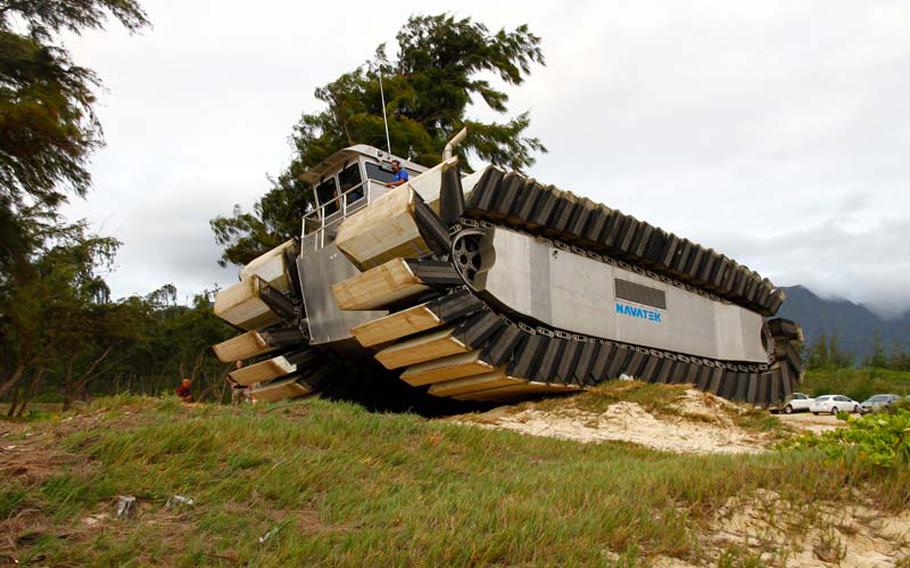Asia-Pacific
VIDEO, PHOTOSUHAC: Marines' amphibious craft propels, paddles in prototype trial
Stars and Stripes July 13, 2014

The Marine Corps Warfighting Lab is overseeing the development of the Ultra Heavy-lift Amphibious Connector, an amphibious craft designed to get over rugged terrain and paddle atop water. (Wyatt Olson/Stars and Stripes)
BELLOWS AIR FORCE STATION, Hawaii — Make way for a new military acronym.
Make way for the UHAC.
That stands for Ultra Heavy-lift Amphibious Connector, and you’re sure to see it coming.
The contraption moves over land with two tank-like tracks that enable it to climb over rugged terrain but also provide buoyancy at sea.
Its movement is kind of a cross between a caterpillar worm and a belly of a snake.
The Marine Corps Warfighting Lab, which is overseeing its development, demonstrated a half-size prototype Friday on beach adjoining the Air Force station on the east side of Oahu — although this junior version still weighs in at 38 tons.
The test was part of the Advanced Warfighting Experiment being conducted during the Navy’s month-long Rim of the Pacific exercise in Hawaii, in which more than 20 partner nations are participating.
The UHAC’s track is made of dozens of durable foam flaps containing “captured air cells,” said Gen. Kevin Killea, commander of the Warfighting Lab, based in Quantico, Virginia.
Killea spoke briefly to a bevy of reporters shortly before the UHAC made a foray from a parking lot, over a sandy berm, across the beach and into the water before returning in about 10 minutes. The plan later in the day was to pilot the UHAC out to a Navy cargo ship at sea, where it would clamber aboard — a largely untested process for the craft. The UHAC would then be loaded with a vehicle, which would be transported back to land.
The prototype stands about 18 feet high, but the final version is expected to maintain a lower profile, without the elevated “cab” the prototype has, Killea said. Killea said the prototype tops out at about 5 mph on the water. The full-size version is expected to move about 25 mph at top speed, he said.
That’s about half the speed of the Navy’s hovercraft, the Landing Craft Air Cushion, or LCAC, an amphibious craft used to shuttle troops and materiel between ship and shore.
But the LCAC isn’t so adept at scrambling over rugged terrain, Killea said. The UHAC can, potentially carrying a heavy payload of supplies to typhoon-damaged areas during humanitarian relief missions.
Despite its aggressive climbing capability, the UHAC’s soft track doesn’t leave much damage where it goes. The foam flaps paddle the water for propulsion, but they flatten out beneath the craft on land, leaving little impression. On Friday, it passed over a tar road without leaving a mark.